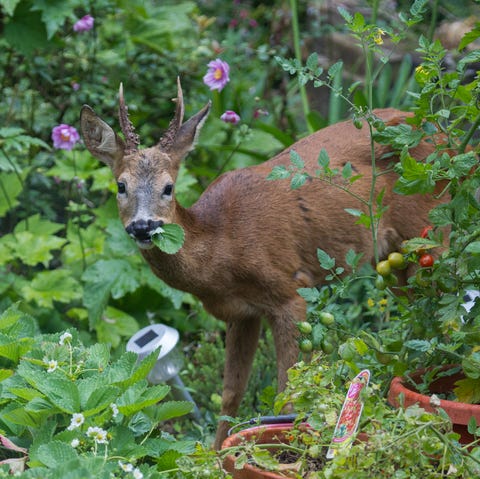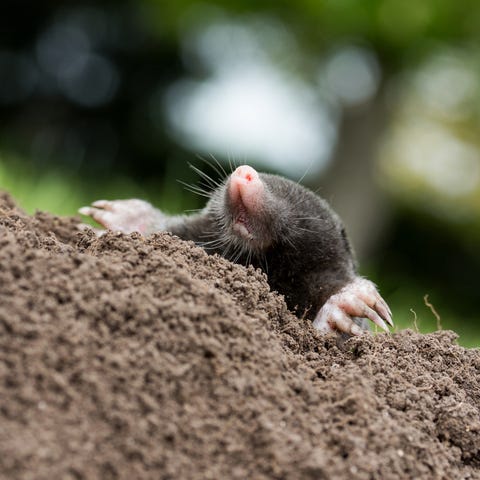How To Deter Critters From Garden
Whether you have a small urban plot or a big, rambling backyard, your friendly neighbors—rabbits, deer, and other critters—will eventually come to call. All those cute little animals are adorable and fun to observe frolicking around your backyard. That is, until they chow down on a row of hostas or devour your seedlings! Then, it might be time to start figuring out how to keep animals out of your garden, or at least away from the flowers and vegetables you're trying to grow.
"With most wildlife, it's really about reducing damage to a tolerable level," says Dr. Scott Hygnstrom, director at Wisconsin Center for Wildlife and professor and extension wildlife specialist at University of Wisconsin-Stevens Point. "What's most effective is to use an integrated approach because there's not one silver bullet for managing every type of wildlife."
In order to prevent your wildlife friends from making your beloved spring flowers and tomato garden their favorite all-you-can-eat buffet, there are steps you can take to keep all the plants you've painstakingly grown safe from harm. While there's the obvious choice of fencing, there are also other tips and tricks to try, whether it's including natural repellants or tweaking landscaping ideas like placing stones instead of mulch. Your garden will be critter-free in no time with these easy-to-do ideas.
This content is imported from {embed-name}. You may be able to find the same content in another format, or you may be able to find more information, at their web site.
One thing to remember, though: Nature is unpredictable. Your neighbor three houses down may have deer problems, while you have no issue. But if you've just learned how to start a vegetable garden or planted new small shrubs and trees, it's smart to be on guard. And it's even smarter to focus on preventing damage, rather than discovering you've lost an entire garden overnight (and yes, it can happen in one night!).
"Most techniques are better as preventive measures," says Paul Curtis, professor and extension wildlife specialist at Cornell University who also coordinates the Wildlife Damage Management program. "Once they know there's something good, wildlife will be more persistent."
How to Keep Rabbits Out of Your Garden

narcisa Getty Images
Wondering if bunnies are the culprits of your nibbled veggies? If so, you'll see tiny, perfectly round droppings and branches or stems will be cut at a clean, sharp angle. "If you install an 18-inch woven garden fence, such as chicken wire, you can eliminate most rabbit damage," says Hygnstrom. "They're not pugnacious, and they'll hit a fence and stop. They're not going to dig under, and the babies aren't going to squeeze through without their moms."
Use chicken wire with 1-inch holes, and pound in metal or fiberglass end posts, then stretch chicken wire taut and wrap around the posts. It's cheap, easy-to-use, and lasts several years. For protecting individual trees or shrubs, create 18-inch tall cylinders from chicken wire or hardware cloth, then pop over each plant, holding them in place with stakes. Rabbits love new plantings, so install fencing immediately for protection.
How to Keep Deer Out of Your Garden

Robert Muckley Getty Images
Deer have no upper incisors so their damage has ragged edges because they bite and tear plants. They'll also feed at any level from the ground up to 6 feet high. The most effective method of management is multifaceted, but you can start by erecting a fence of 6 to 8 feet in height, says Hygnstrom. Though deer can jump much higher than that, it's unlikely they'll do so because they'd rather take the easy route to dinner.
On the other hand, fences aren't always practical, especially when it comes to your flower beds or front yard. Motion-activated frightening devices such as sprinklers or objects that emit deer distress calls may help. These only go off when deer walk through, and they can be one part of your overall management plan— though deer sometimes get used to these devices after repeated exposure.
You also can try repellents made from putrescent egg (yes, they reek like rotten eggs, but the smell fades!) and other natural substances such as capsaicin. "Get them down early before deer establish a feeding pattern," says Hyngstrom. "But be aware that based on research, repellants are effective about half the time." As for homemade remedies such as bars of soap, hair, or coyote urine (yes, it's a thing!), they're even less effective. If you do try commercial repellents, follow the label because some require you to reapply regularly or after rains.
Even with all these methods put into place, some plants are just irresistible to deer. If possible, fill your garden with plants deer are less likely to devour and avoid their favorites such as hostas, daylilies, and roses if you live in deer country.
How to Keep Rodents Out of Your Garden

juefraphoto Getty Images
Voles are herbivores, and they tunnel right beneath the surface of snow, leaf mulch, and grasses. They like to eat bulbs, roots, and tree bark and will often eat around the base of trees. Your best defense? "Reduce the habitat by placing stones instead of mulch near the base of valued trees," says Curtis. "Or bury a cylinder of 1/4-inch mesh hardware cloth several inches deep around trees you want to protect."
Moles, which eat grubs, earthworms, and other insects, also tunnel near the surface and leave volcano-shaped mounds of soil in your lawn. You can try repellents such as castor oil, which might work. Avoid using poison pellets, which don't interest them because they eat bugs, not bait! Pellets also are a risk to curious pets and other wildlife.
Using insecticides to reduce insect populations also isn't recommended, because it harms beneficial insects, such as earthworms. Plus, moles simply may redouble their digging efforts! Moles are often found in wet areas, so improving soil drainage may help, in addition to other preventative measures like fencing.
When to Call in Wildlife Experts
If you're having critter issues that you can't seem to get control, you may need to hire a wildlife management service. For example, woodchucks, also called groundhogs, are some of the toughest wildlife to manage, says Curtis. They're intelligent and can burrow and climb so most fences are useless unless you bury them at least 4-inches deep with an outward-facing apron to deter digging. If you're up against a wily groundhog, it's likely time to get some help.
Top Tools for Keeping Critters Out of Your Garden
This content is created and maintained by a third party, and imported onto this page to help users provide their email addresses. You may be able to find more information about this and similar content at piano.io
How To Deter Critters From Garden
Source: https://www.thepioneerwoman.com/home-lifestyle/gardening/a36233722/how-to-keep-animals-out-of-garden/
Posted by: brownsproas.blogspot.com

0 Response to "How To Deter Critters From Garden"
Post a Comment